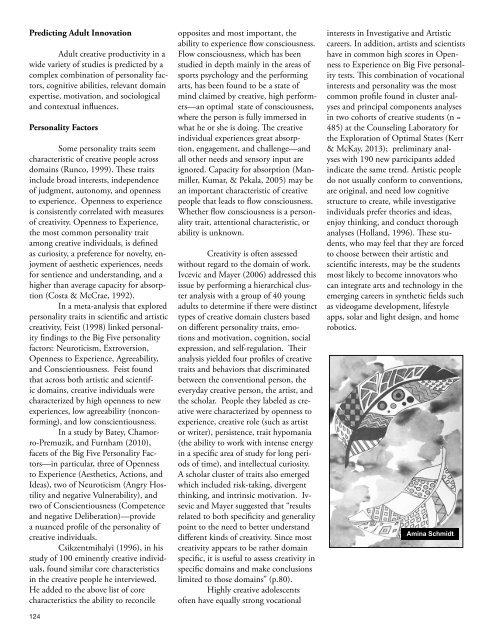Torrance Journal for Applied Creativity
TorranceJournal_V1
TorranceJournal_V1
Create successful ePaper yourself
Turn your PDF publications into a flip-book with our unique Google optimized e-Paper software.
Predicting Adult Innovation<br />
Adult creative productivity in a<br />
wide variety of studies is predicted by a<br />
complex combination of personality factors,<br />
cognitive abilities, relevant domain<br />
expertise, motivation, and sociological<br />
and contextual influences.<br />
Personality Factors<br />
Some personality traits seem<br />
characteristic of creative people across<br />
domains (Runco, 1999). These traits<br />
include broad interests, independence<br />
of judgment, autonomy, and openness<br />
to experience. Openness to experience<br />
is consistently correlated with measures<br />
of creativity. Openness to Experience,<br />
the most common personality trait<br />
among creative individuals, is defined<br />
as curiosity, a preference <strong>for</strong> novelty, enjoyment<br />
of aesthetic experiences, needs<br />
<strong>for</strong> sentience and understanding, and a<br />
higher than average capacity <strong>for</strong> absorption<br />
(Costa & McCrae, 1992).<br />
In a meta-analysis that explored<br />
personality traits in scientific and artistic<br />
creativity, Feist (1998) linked personality<br />
findings to the Big Five personality<br />
factors: Neuroticism, Extroversion,<br />
Openness to Experience, Agreeability,<br />
and Conscientiousness. Feist found<br />
that across both artistic and scientific<br />
domains, creative individuals were<br />
characterized by high openness to new<br />
experiences, low agreeability (noncon<strong>for</strong>ming),<br />
and low conscientiousness.<br />
In a study by Batey, Chamorro-Premuzik,<br />
and Furnham (2010),<br />
facets of the Big Five Personality Factors—in<br />
particular, three of Openness<br />
to Experience (Aesthetics, Actions, and<br />
Ideas), two of Neuroticism (Angry Hostility<br />
and negative Vulnerability), and<br />
two of Conscientiousness (Competence<br />
and negative Deliberation)—provide<br />
a nuanced profile of the personality of<br />
creative individuals.<br />
Csikzentmihalyi (1996), in his<br />
study of 100 eminently creative individuals,<br />
found similar core characteristics<br />
in the creative people he interviewed.<br />
He added to the above list of core<br />
characteristics the ability to reconcile<br />
124<br />
opposites and most important, the<br />
ability to experience flow consciousness.<br />
Flow consciousness, which has been<br />
studied in depth mainly in the areas of<br />
sports psychology and the per<strong>for</strong>ming<br />
arts, has been found to be a state of<br />
mind claimed by creative, high per<strong>for</strong>mers—an<br />
optimal state of consciousness,<br />
where the person is fully immersed in<br />
what he or she is doing. The creative<br />
individual experiences great absorption,<br />
engagement, and challenge—and<br />
all other needs and sensory input are<br />
ignored. Capacity <strong>for</strong> absorption (Manmiller,<br />
Kumar, & Pekala, 2005) may be<br />
an important characteristic of creative<br />
people that leads to flow consciousness.<br />
Whether flow consciousness is a personality<br />
trait, attentional characteristic, or<br />
ability is unknown.<br />
<strong>Creativity</strong> is often assessed<br />
without regard to the domain of work.<br />
Ivcevic and Mayer (2006) addressed this<br />
issue by per<strong>for</strong>ming a hierarchical cluster<br />
analysis with a group of 40 young<br />
adults to determine if there were distinct<br />
types of creative domain clusters based<br />
on different personality traits, emotions<br />
and motivation, cognition, social<br />
expression, and self-regulation. Their<br />
analysis yielded four profiles of creative<br />
traits and behaviors that discriminated<br />
between the conventional person, the<br />
everyday creative person, the artist, and<br />
the scholar. People they labeled as creative<br />
were characterized by openness to<br />
experience, creative role (such as artist<br />
or writer), persistence, trait hypomania<br />
(the ability to work with intense energy<br />
in a specific area of study <strong>for</strong> long periods<br />
of time), and intellectual curiosity.<br />
A scholar cluster of traits also emerged<br />
which included risk-taking, divergent<br />
thinking, and intrinsic motivation. Ivsevic<br />
and Mayer suggested that “results<br />
related to both specificity and generality<br />
point to the need to better understand<br />
different kinds of creativity. Since most<br />
creativity appears to be rather domain<br />
specific, it is useful to assess creativity in<br />
specific domains and make conclusions<br />
limited to those domains” (p.80).<br />
Highly creative adolescents<br />
often have equally strong vocational<br />
interests in Investigative and Artistic<br />
careers. In addition, artists and scientists<br />
have in common high scores in Openness<br />
to Experience on Big Five personality<br />
tests. This combination of vocational<br />
interests and personality was the most<br />
common profile found in cluster analyses<br />
and principal components analyses<br />
in two cohorts of creative students (n =<br />
485) at the Counseling Laboratory <strong>for</strong><br />
the Exploration of Optimal States (Kerr<br />
& McKay, 2013); preliminary analyses<br />
with 190 new participants added<br />
indicate the same trend. Artistic people<br />
do not usually con<strong>for</strong>m to conventions,<br />
are original, and need low cognitive<br />
structure to create, while investigative<br />
individuals prefer theories and ideas,<br />
enjoy thinking, and conduct thorough<br />
analyses (Holland, 1996). These students,<br />
who may feel that they are <strong>for</strong>ced<br />
to choose between their artistic and<br />
scientific interests, may be the students<br />
most likely to become innovators who<br />
can integrate arts and technology in the<br />
emerging careers in synthetic fields such<br />
as videogame development, lifestyle<br />
apps, solar and light design, and home<br />
robotics.<br />
Amina Schmidt


